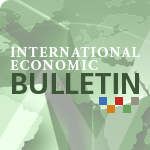The Real Economy: Output, GDP, and Inflation
Modest improvements in confidence surveys, durable goods orders, and consumer spending signaled farther stabilization in the global economy.
Improvements in U.S. durable good orders and consumer spending strengthened optimism for recovery. Durable goods orders rose by 1.8 percent in May, much of which was fuelled by a sharp 7.7 percent increase in new machinery orders. The University of Michigan consumer sentiment index rose for the fourth consecutive month, jumping to 70.8 in June from 60.7 in May. Tax cuts and increased social security payments from the government’s stimulus plan helped to boost household incomes. Consumer spending increased by 0.3 percent in May, while personal income rose by 1.4 percent. The savings rate surged to 6.9 percent over the same period, the highest level since 1993.
Housing markets continued to show signs of bottoming out. Sales of existing homes increased by 2.4 percent to an annual rate of 4.77 million in May, helped by the lower mortgage rates earlier in the year when these deals were contracted. In contrast, new home sales dropped to an annual rate of 342,000 units in May from 344,000 in April.
Sentiment indicators continued to improve across Europe. The Eurozone manufacturing PMI rose to 42.4 in June from 40.7 from the previous month, while German IFO index increased to 85.9 from 84.2 over the same period. Yet despite these improvements, new industrial orders dropped 1 percent in April after a 0.2 percent decline in March.
In Asia, Japan is moving into a deflationary territory as consumer price inflation dropped by 1.1 percent in May (y/y), after falling at 0.1 percent in the previous two months. Sentiment among Japan’s large manufacturers rose to negative 13.2 points, up from a record low of negative 66 three months ago. The OECD revised upwards its forecast for China's 2009 GDP growth to 7.7 percent, up from the 6.3 percent predicted in March.
Economic Policy
The U.S. Federal Reserve announced that the Fed Funds Target Rate would remain unchanged at 0-0.25 percent and decided against increasing its $1.75 trillion credit easing program, suggesting that the Fed expects the pace of economic contraction to continue to slow and inflation to remain subdued for the foreseeable future. Additionally, the Fed noted improving conditions in financial markets over recent months.
Other major central banks also left their interest rates unchanged. The Bank of Hong Kong left its benchmark rate unchanged at 0.5 percent, Taiwan’s central bank kept its benchmark interest rate unchanged at a record low of 1.25 percent. South Africa’s and Hungary’s central banks kept interest rates on hold at 7.5 percent and 9.5 percent, respectively.
The European Central Bank (ECB) poured $620 billion of one-year funds into money markets last week in an effort to spur lending by providing banks with enough financial security to make more long-term loans to companies and consumers.
Financial Markets
U.S. equity markets ended the week with mixed results. Only the Nasdaq ended in positive territory, with a gain of 0.6 percent. The S&P was down by 0.3 percent and the Dow by 1.2 percent. This was the second consecutive week of losses for both the S&P and Dow, the first double-week drop since the rally began in March.
European and Asian equity markets fell last week. The UK FTSE 100, the German DAX and the French CAC dropped by 2.4 percent, 1.3 percent and 2.5 percent, respectively. Japan’s Nikkei 225 closed down by 0.9 percent.
The yield on U.S.10-year treasury bills fell to 3.5 percent, down 29 basis points over the week. In Europe, the UK 10-year bond was down 13 basis points to 3.68 percent. Japan’s 10-year bond yield fell modesty by 6 basis points.
The cost of borrowing in dollars for three months fell below 0.6 percent for the first time last week. The London Interbank Offered Rate, or Libor, dropped a basis point to 0.59 percent, taking its year-to-date decline to 83 basis points.
In the currency market, the Euro strengthened by 1 percent versus the U.S. dollar, while the pound sterling was almost unchanged at $1.65 for the week. The U.S. dollar ended weaker against the Japanese yen, falling to ¥95.9 from ¥96.3.





